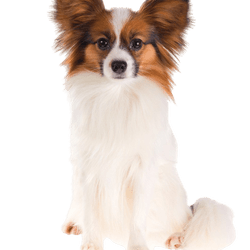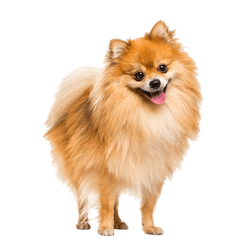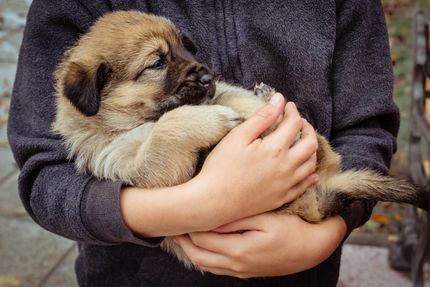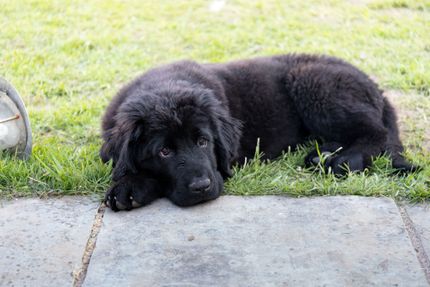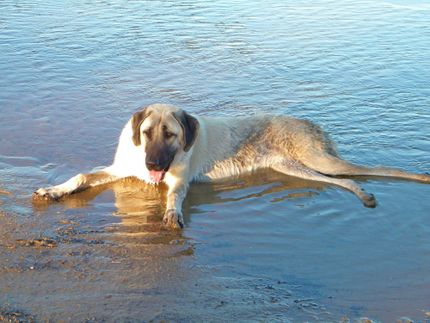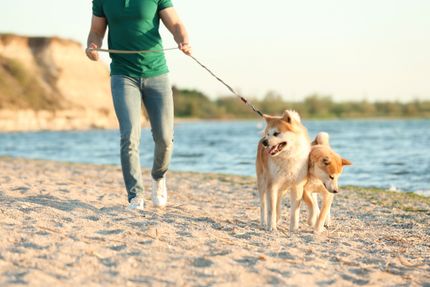Paperanian:Papillon and Pomeranian Mix
Facts & Origin
Papillon and Pomeranian mix - a hybrid breed.
The Papillon and Pomeranian mix is a small, active dog that is great for families. They are intelligent, easy to train and love to play. They are also good watchdogs.
What are breed characteristics of this mix dog?
The Papillon-Pomeranian mix breed has a petite but muscular build. They typically weigh between 3 and 4 kg and measure between 25 and 30 cm at the shoulder. They have a dense, double coat that is usually white with different colored patches. They have large, erect ears that sit high on the head and a long, fluffy tail that is often curled over the back.
| Alternate Name | - |
| Origin | France - Germany |
| Life expectancy | 12 - 16 years |
| Care requirements | low-maintenance - high-maintenance |
| Activity level | average - low |
| FCI group | not recognised |
| AKC group | not recognised |
| KC group | not recognised |
More Papillon mixes
More Pomeranian mixes
Attitude, character and temperament of the breed
Possible character traits of Papillon and Pomeranian mix - Such is probably his nature.
Papillon and Pomeranian mixes are popular because of their small size, affectionate nature, and adorable, teddy bear-like appearance. Also known as Pom-A-Poo or Pooranian, this mixed breed is a combination of two purebred dogs - the Papillon and the Pomeranian.
These dogs are alert and make excellent watchdogs, but they are also gentle and loving, which makes them ideal companions. They are intelligent and easy to train, although they can be stubborn at times.
Papillon and Pomeranian mixes are usually healthy, but like all dogs, they can be prone to some health problems, such as patellar luxation, so it is important to consult a veterinarian before acquiring such a dog.
This mixed breed is not for everyone, as it requires some care and may not be suitable for families with small children. But if you are looking for a small, loving and extremely loyal companion, a Papillon-Pomeranian mix could be the perfect dog for you.
Character
Usage


Health and breeding information
What diseases can occur in Papillon and Pomeranian Mix.
Papillon Pomeranian mixes are generally healthy dogs, but like all breeds, they are prone to certain health disorders. The most common health problems in Papillon Pomeranians include patellar dislocation, joint problems, dental decay, and eye disease.
Patellar dislocation is a common problem in small dogs, and Papillon Pomeranians are no exception. This condition, also known as patellar luxation, causes the kneecap to slip out of position. This can be very painful for your dog and may require surgery to correct.
Joint problems are also common in Papillon Pomeranians, especially as they get older. Arthritis and hip dysplasia are the most common joint problems that occur in this breed. Both conditions can lead to pain and limited movement.
Tooth decay is another common health problem in Papillon Pomeranians. Due to their small size, their teeth are very close together, making it easy for plaque and tartar to form. This can lead to tooth decay and gum disease. Regular brushing and dental exams can help prevent this problem.
Eye disease is also relatively common in Papillon Pomeranians. Cataracts and glaucoma are two of the most common eye problems in this breed. Both conditions can cause vision problems and even blindness if left untreated. Regular eye exams by a veterinarian can help detect these problems early.
What does this mixed breed look like?
The Papillon-Pomeranian mix breed is a small dog with a lot of personality. They have a silky, solid coat that comes in many colors, including black, white, cream, apricot, orange and brown. The most noticeable feature of this breed is their large, erect ears, which give them a wary and friendly appearance.
| Fur length | long |
| Fur | flat coated |
| Ear shape | Standing Ears |
| Tail | rolled up |
| Anatomy | slim, slim, square |
| Size ♀ | 12 - 30 cm |
| Weight ♀ | 2 - 5 kg |
| Size ♂ | 17 - 30 cm |
| Weight ♂ | 2 - 5 kg |
| Suitable For | - |
Known Diseases
Patellar luxation
Patellar luxation is the term used to describe a displacement of the kneecap, which is one of the most common causes of lameness in dogs.
Tartar
If dogs don't get a good food or sugary food, tartar can quickly appear.
Eye infections
Chronic eye infections can be very painful in dogs and can be treated with medication. In rare cases, the cornea must be treated.
Elbow dysplasia (ED)
Elbow joint dysplasia is a chronic disease complex of the elbow joint of fast growing dog breeds.
Heart disease
Can occur frequently in dogs and can sometimes be treated with medication.
Hip dysplasia (HD)
The hip dysplasia or hip joint dysplasia of the dog (HD) is a maldevelopment of the hip joint.
Numbness
Often occurs in old age.
FAQ
-
The Papillon is a small dog breed, while the Pomeranian is a dwarf dog breed. Both breeds are friendly and good with children. However, the Pomeranian is known to be louder than the Papillon.
-
There is no definitive answer as to which is better. It really depends on what you want from a dog and what your personal preferences are.
Useful Articles
You can find articles that might interest you in the dogbible blog to match your favorite breed.
Visit our magazineto stay up to date on dog trends.
To find out more, view our Privacy Policy
Find here the breed that suits you and find out what character traits it has. Here you can also learn more about the origin, size and weight of your favorite breeds.
Matching your favorite breed, you'll find articles that might interest you on the dogbible dog blog.
Cooking dog food yourself - advantages and disadvantages
